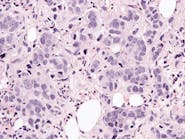Studies of interactions between two lab-generated monoclonal antibodies (mAbs) and an essential Epstein-Barr virus (EBV) protein have uncovered targets that could be exploited in designing treatments and vaccines for this extremely common virus.
The research was led by Jeffrey I. Cohen, M.D., and colleagues from the National Institute of Allergy and Infectious Diseases (NIAID), part of the National Institutes of Health. Study findings were published in the journal Immunity.
In this study, NIAID investigators examined a viral protein called gp42, which the virus must use to infect B cells. Theoretically, a vaccine or antibody-based treatment capable of blocking gp42’s ability to bind to or fuse with B cells would prevent EBV infection and, thus, the virus’s ability to persist in those cells. The team generated two gp42-specific mAbs, A10 and 4C12, and used X-ray crystallography to visualize how they interacted with gp42. The crystal structures revealed that the two mAbs interacted with distinct, non-overlapping sites on gp42. Monoclonal antibody A10 blocked the site on gp42 required for receptor binding, while 4C12 interfered with a different site that is involved in membrane fusion.
If future studies show mAb A10 to be safe and effective in humans, it could have clinical applications, particularly in people who have not been infected with EBV; those with immunodeficiency conditions, including severe combined immunodeficiency; or people receiving transplants.





